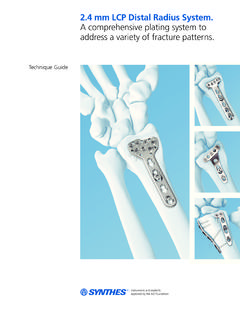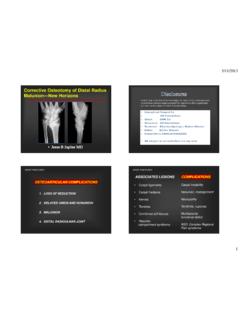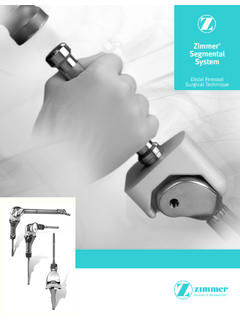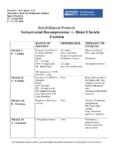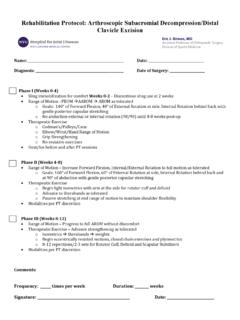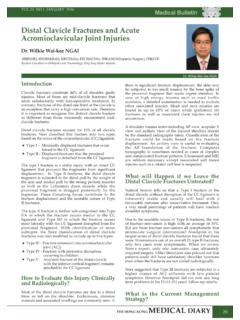Transcription of Distal Phalangeal and Fingertip Injuries - leohanddoc.com
1 Chapter 3 Distal Phalangeal and Fingertip InjuriesLeo M. Rozmaryn, MDDistal Phalangeal skeletal and soft tissue Injuries are exceedingly common. Taken in their entirety, they constitute the largestpercentage of hand Injuries seen in the emergency room. The scenarios in which they occur constitute the full palette of humanendeavor from work, sports, and the home. They are a leading cause of time lost from work and workers compensation are affected as often as adults. Fingertip Injuries represent a broad spectrum of conditions, each with its own set of issuesin diagnosis and of Injuries vary widely from crush, avulsion and degloving, laceration, amputation, eccentric tendon overuse, andhyperflexion or extension of the Distal phalanx. They can involve any and all of the structures in the Fingertip , and Injuries can beopen or closed. High pressure injection Injuries are a special type of Fingertip injury resulting in a mini compartment syndrome inthe volar pad of the finger that, if not addressed promptly, can result in irreversible ischemia or in gangrene and eventualamputation of the tip.
2 Closed Injuries can result in fracture of the Distal phalanx, dislocation and collateral ligament Injuries of thedistal interphalangeal (DIP) joint, closed avulsions of the flexor digitorum profundus (FDP) and mallet fingers, and articular damagethat may lead to Injuries include dorsal and volar lacerations resulting in trauma to the nail complex or the terminal flexor and extensortendons and digital nerves and nail bed crush and avulsion Injuries , which can coexist with open fracture of the Distal Injuries to the dorsal or volar skin frequently accompany crush Injuries to the Fingertip . In extreme cases, the tip of thefinger may be amputated by a sharp instrument, leaving a deficit that is either transverse or oblique. Such an injury may occur inthe sagittal or coronal plane or the defect can be amorphous such as in a severe crush injury. Amputations frequently haveexposed of these Injuries can vary widely from simple splinting to complex microvascular reconstruction.
3 The goal oftreatment is to restore an aesthetically pleasing, painless, tactile, mobile, stable Fingertip that can sense pain, temperature,pressure, stereognosis, and fine touch. The Fingertip must also be the terminus of the gripping mechanism of the , all too often, these Injuries are underrecognized (and, therefore, undertreated), resulting in persistent tipnumbness, cold sensitivity, nail growth abnormalities, nail fold and volar pad deformities, hypesthesia, dysesthesia, and painfulstiffness of the DIP joint. A knowledgeable hand surgeon ideally is the most appropriate person to manage these purpose of this chapter is to outline the various categories of injury to the Fingertip and Distal phalanx, anatomy,physiology, mechanism of injury, treatment options, outcomes, and possible complications. Hopefully, it will serve to increaseawareness of these frequently undertreated Injuries and lead to better Phalanx FracturesDistal phalanx fractures are the most common fracture seen in the hand.
4 In 1988, Schneider1 classified these fractures into 4types:Tuft fractures: simple and comminutedShaft fractures: transverse stable and unstable, longitudinalArticular fractures: volar (profundus avulsion), dorsal malletEpiphyseal: child (Salter I or II), adolescent (Salter III)Tuft FracturesTuft fractures are generally associated with crush Injuries and may be accompanied by open and closed Injuries to the nail bed orvolar pad. The force of the crush and its duration will determine the extent of the injury. Less severe Injuries are frequentlyaccompanied by mild swelling and ecchymosis (Figure 3-1). As the severity of the crush increases, the volar pad can become turgidand a subungual hematoma may develop as the sterile matrix of the nail bed lacerates under a nail plate that is otherwiseadherent at the edges (Figure 3-2A). This laceration creates a communication between the tuft fracture and the underside of thenail plate.
5 Eventually, the nail plate avulses and the nail bed lacerates. The bony tuft may or may not rupture through the sterilematrix of the nail bed. The laceration can extend around the nail folds to the volar side (Figure 3-3). If the crush is severe enough,the tip may simply amputate with or without the crushed 3-1 Mild crush injury to the third and fourth fingertips. Note the swelling and the ecchymosisFigure 3-2 A-C Subungual hematoma of more than 60% of the sterile matrix drained with an ophthalmic cautery using sterile technique. Relief is 3-3 Complex nail bed laceration, burst pattern extending to the volar surface of the digit. To expose the germinal matrix, the eponychial fold is peeledback by making 2 oblique incisionsGenerally, if the injury to the soft tissue is mild, the tuft requires no open treatment. In these cases, the tuft fracture isnondisplaced, and simple immobilization for 2 to 3 weeks in a total contact plaster cast or thermoplastic molded splint will suffice(Figure 3-4).
6 These fractures may fail to achieve radiographic bony union; rather, a functional painless fibrous union may should not include the proximal interphalangeal (PIP) joint because stiffness there may result. At 3 weeks, the DIPjoint should be stretched to achieve maximal range of 3-4 Plaster total contact splint for nondisplaced or minimally displaced fractures of the Distal phalanx. With monitoring, these can even be used inthe face of a closed crush injury. These frequently become loose and need replacement. Full proximal interphalangeal motion is hematomas are exquisitely painful, and if involving more than 50% of the sterile matrix, they will requiredecompression. Traditionally, a heated paperclip was used to trephine a hole in the nail plate just past the lunula. More recently, abattery-powered electric cautery provides much higher heat and will painlessly burn a drainage hole in the nail plate (see Figure 3-2B, C).
7 The sense of relief is immediate and intense. The Fingertip is immobilized for about 2 weeks and a range of motion programis begun. It must be noted that creating a hole in the nail plate converts the closed tuft fracture into an open one so that there isthe risk of developing a subungual abscess that may extend into the Distal phalanx. The trephination must be done under steriletechnique. Recent evidence suggests that prophylactic antibiotics are not necessary unless the nail plate is has been controversy of late as to whether patients who present with subungual hematomas can be treated simply withtrephination or whether complete removal of the nail plate with repair of the nail bed necessary. Roser and Gellman3 comparedthe two techniques and found no difference in final outcome regardless of the size of the hematoma or the associated fracture. Itis now recommended to simply trephine the hematoma if it is greater than 50% of the nail This assumes that the underlyingfracture is nondisplaced.
8 If there is displacement, then full open treatment including nail bed repair, fracture reduction, andinternal fixation may be FracturesSchneider1 described 2 types of shaft fractures of the Distal phalanx transverse and longitudinal. Transverse fractures are mostoften caused by crush Injuries accompanied by a bending moment, usually in flexion. They can be nondisplaced and stable ordisplaced and unstable. They can also be entirely closed or the Distal fragment, while displacing into flexion, can herniate throughthe sterile matrix, usually avulsing the proximal nail plate out of the eponychial fold. The extent of the injury can beunderappreciated. An unknowledgeable treating physician may simply tuck the nail plate back in and stabilize it with a suture(Figure 3-5). The underlying fracture and sterile matrix laceration are then left untreated, with serious consequences for nailgrowth.
9 The open nail matrix can be a conduit for soft tissue infection and/or osteomyelitis of the Distal phalanx. In higher-energyinjuries, the nail folds and the volar pulp can be avulsed as well. Longitudinal fractures may also be open or closed and are usually aresult of a crush injury. They can be extra-articular or may extend into the DIP joint (Figure 3-6).Figure 3-5 Nail bed injury repaired by emergency room staff by tucking in the avulsed nail plate. The underlying fracture was not addressed, and uponremoving the nail plate, the underlying Distal phalanx was seen herniating through the sterile matrix with the proximal fold caught underneath the 3-6 A, Nondisplaced longitudinal fracture. B, Angulated transverse basilar fracture. C, Comminuted unstable (pilon) intra-articular fracture. D,Displaced basilar intra-articular fracture. E, Comminuted segmental displaced fracture. F, Highly comminuted fracture of the Distal phalanx.
10 G, Transversenondisplaced waist fracture. H, Nondisplaced Distal tuft treatment of these injures varies with the clinical presentation and severity of injury. Nondisplaced, closed fractures,either transverse or longitudinal, are generally treated with a splint or protective covering from the tip to the proximal end of themiddle phalanx, for about 2 to 4 weeks in order to allow the pain and swelling to subside and to prevent reinjury while encouragingPIP motion. Protected range of motion exercise to the DIP joint is then begun. The tip may still need protection for an additional 2weeks with a soft cover such as a Coban wrap (3M, Minneapolis).Displaced, closed Injuries to the Distal phalanx shaft may need to be reduced anatomically and stabilized in order to preventsubsequent injury to the overlying sterile matrix and late nail deformity. If this cannot be achieved by closed reduction andsplinting, it may be accomplished with a longitudinal K-wire or small screw placed Distal to proximal.
